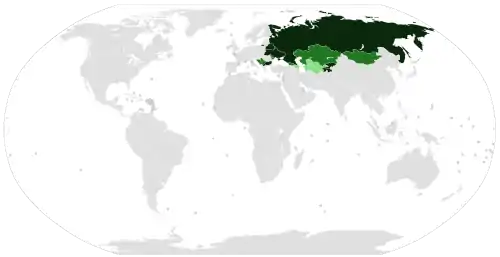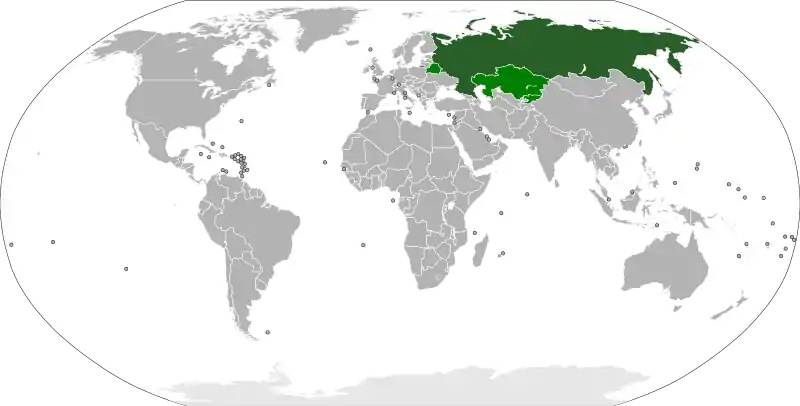东欧文化圈
東歐文化圈(又被稱爲斯拉夫文化圈、東正教文化圈、西里爾文化圈),文化上亦屬於廣義的西方世界,其範圍主要為東歐(前蘇聯和巴爾幹半島)地區。其特徵為:多為斯拉夫民族,民衆多信奉東正教(基督正教),廣泛使用西里爾字母。
西里尔字母

使用西里爾字母的地區在全世界的分布

說俄語的地區在全世界的分布
西里尔字母源于脱胎自希腊字母的格拉哥里字母,普遍认为是由基督教传教士圣西里尔(827年-869年)和聖梅篤丟斯在9世纪为了在斯拉夫民族传播基督教(当时东西教会还未正式分裂)方便所创立的,被斯拉夫民族广泛采用,因此有时也称为斯拉夫字母。早期的西里尔字母又称作古斯拉夫語字母(現代的斯拉夫字母經過修改)。
東正教
東正教是基督宗教中的一個派別,主要是指依循由東羅馬帝國(又稱拜占庭帝國)所流傳下來的基督信仰傳統的教會。它是與天主教、基督新教並立的基督宗教三大派別之一。「正教」的希臘语(Orthodxia)意思是正統。
斯拉夫民族
斯拉夫民族發源於今波蘭東南部維斯杜拉河上游一帶,於西元一世紀時開始向外遷徙,至六世紀時期居地已經遍布東歐以及俄羅斯地區。依居住地的不同,斯拉夫民族可分成東、西、南三支,其中東支主要分布於前蘇聯境內,分布在東歐各地者以西、南兩支為主。
使用斯拉夫語及西里爾字母的國家和地區列表
| 國家 | 使用者 | 百分率 | 年份 | 参考 |
|---|---|---|---|---|
| 23,484 | 0.8% | 2011 | [1] | |
| 44,058 | 0.2% | 2012 | [1] | |
| 8,446 | 0.1% | 2001 | [1] | |
| 122,449 | 1.4% | 2009 | [1] | |
| 6,672,964 | 70.2% | 2009 | [1] | |
| 112,150 | 0.3% | 2011 | [1] | |
| 1,592 | 0.04% | 2011 | [1] | |
| 20,984 | 2.5% | 2011 | [1] | |
| 31,622 | 0.3% | 2011 | [1] | |
| 383,118 | 29.6% | 2011 | [1] | |
| 54,559 | 1.0% | 2010 | [1] | |
| 16,355 | 0.4% | 2002 | [1] | |
| 1,155,960 | 15% | 2011 | [2] | |
| 2,104 | 0.14% | 2009 | [1] | |
| 4,351,404 | 23.7% | 2016 | [1] | |
| 482,200 | 8.9% | 2009 | [3] | |
| 698,757 | 33.8% | 2011 | [1] | |
| 218,383 | 7.2% | 2011 | [1] | |
| 40 | 0.003% | 2011 | [1] | |
| 380,796 | 11.3% | 2004 | [1] | |
| 7,896 | 0.2% | 2006 | [1] | |
| 16,833 | 0.3% | 2012 | [1] | |
| 21,916 | 0.1% | 2011 | [1] | |
| 18946 | 0.09% | 2011 | [1] | |
| 137,494,893 | 96.2% | 2010 | [1] | |
| 3,179 | 0.04% | 2011 | [1] | |
| 1,866 | 0.03% | 2001 | [1] | |
| 40,598 | 0.5% | 2012 | [1] | |
| 634,958 | 12.0% | 2016 | [1] | |
| 14,273,670 | 29.6% | 2001 | [1] | |
| 879,434 | 0.3% | 2013 | [4] | |
| 4,185,253 | 14.2% | 2016 | [1] |
以東歐文化圈為主的國家
| 民族 | 民族国家 | 人口的大概数字 | |
|---|---|---|---|
| 俄罗斯人 | 130,000,000–150,000,000 | [5][6][7] | |
| 波兰人 | 57,393,000–60,000,000 | [8][9][10][11] | |
| 乌克兰人 | 46,700,000–51,800,000 | [12] | |
| 塞尔维亚人 | 11,500,000–12,500,000 | [13][14] | |
| 捷克人 | 10,000,000–12,000,000 | [15] | |
| 保加利亚人 | 10,000,000 | [16][17] | |
| 白俄罗斯人 | 10,000,000 | [18] | |
| 克罗地亚人 | 9,000,000 | [19][20][21] | |
| 斯洛伐克人 | 6,940,000 | [22] | |
| 波什尼亚克人 | 2,800,000–4,600,000 | ||
| 斯洛文尼亚人 | 2,500,000 | [22] | |
| 马其顿人 | 2,100,000 | [23][24] | |
| 黑山人 | 560,000 | ||
| 摩尔多瓦人 | 2,998,235 | ||
注釋
- Based on a 2011 population of 7,706,400 (Central Bureau of Statistics of Israel)
參考文獻
- . UNdata. [13 October 2015]. (原始内容存档于2016-05-19).
- Israel Central Bureau of Statistics. . [12 October 2013]. (原始内容存档于2013年10月13日).
- (PDF). UN Stats. [1 November 2015]. (原始内容 (PDF)存档于2012-07-10).
- . American FactFinder. [3 April 2015]. (原始内容存档于2015-04-04).
- Estimates range between 130 and 150 million. 111 million in the Russian Federation (2010 census), about 16 million ethnic Russians in post-Soviet states (8 M in Ukraine, 4.5 M in Kazakhstan, 1 M in Belarus, 0.6 M Latvia, 0.6 M in Uzbekistan, 0.6 M in Kyrgyzstan. Up to 10 million Russian diaspora elsewhere (mostly Americas and Western Europe).
- . Russkie.org. 20 February 2012 [29 April 2013]. (原始内容存档于2018-12-25).
- . web.archive.org. 23 June 2012.
- 37.5–38 million in Poland and 21–22 million ethnic Poles or people of ethnic Polish extraction elsewhere. "Polmap. Rozmieszczenie ludności pochodzenia polskiego (w mln)" 页面存档备份,存于
- including 36,522,000 single ethnic identity, 871,000 multiple ethnic identity (especially 431,000 Polish and Silesian, 216,000 Polish and Kashubian and 224,000 Polish and another identity) in Poland (according to the census 2011 页面存档备份,存于) and estimated over 20,000,000 Polish Diaspora Świat Polonii, witryna Stowarzyszenia Wspólnota Polska: "Polacy za granicą" 页面存档备份,存于 (Polish people abroad as per summary by Świat Polonii, internet portal of the association Wspólnota Polska)
- Główny Urząd Statystyczny. [Narodowy Spis Powszechny Ludności i Mieszkań 2011] (PDF). Główny Urząd Statystyczny. January 2013: 89–101 [12 December 2014]. (原始内容存档 (PDF)于2014-10-27) (波兰语).
- (PDF). Warsaw: Główny Urząd Statystyczny. November 2015: 129–136 [2020-12-09]. ISBN 978-83-7027-597-6. (原始内容存档 (PDF)于2019-08-08) (波兰语).
- Paul R. Magocsi. . University of Toronto Press. 2010: 10–. ISBN 978-1-4426-1021-7.
- (PDF). Novosti: 5. May 2014 [2019-11-02]. (原始内容 (PDF)存档于2019-06-05).
- (PDF). Serbian Unity Congress. 2013 [2020-12-09]. (原始内容 (PDF)存档于2013-12-05).
- [Table. 6.2 Population by nationality, by region] (PDF). Czech Statistical Office. 2011 [2020-12-09]. (原始内容 (PDF)存档于2012-01-31) (捷克语).
- Kolev, Yordan, Българите извън България 1878 – 1945, 2005, р. 18 Quote:"В началото на XXI в. общият брой на етническите българи в България и зад граница се изчислява на около 10 милиона души/In 2005 the number of Bulgarians is 10 million people
- . Oxford Business Group. 2008: 8 [26 March 2016]. ISBN 978-1-902339-92-4.
- Karatnycky, Adrian. . Piscataway, NJ: Transaction Publishers. 2001: 81 [7 June 2015]. ISBN 978-0-7658-0884-4. (原始内容存档于2020-07-22).
- Daphne Winland, , Melvin Ember; Carol R. Ember; Ian Skoggard (编), 2 illustrated, Springer Science+Business: 76, 2004 [2020-12-09], ISBN 978-0-306-48321-9, (原始内容存档于2016-05-08),
It is estimated that 4.5 million Croatians live outside Croatia ...
- . [1 June 2016]. (原始内容存档于2003-06-23)., Croatian World Congress, "4.5 million Croats and people of Croatian heritage live outside of the Republic of Croatia and Bosnia and Herzegovina"
- Palermo, Francesco. . Francesco Palermo (编). . Natalie Sabanadze. Martinus Nijhoff Publishers. 2011: 11. ISBN 978-90-04-17598-3.
- including 4,353,000 in Slovakia (according to the census 2011), 147,000 single ethnic identity, 19,000 multiple ethnic identity (especially 18,000 Czech and Slovak and 1,000 Slovak and another identity) in Czech Republic (according to the census 2011), 53,000 in Serbia (according to the census 2011 页面存档备份,存于), 762,000 in the USA (according to the census 2010 Archive.is的存檔,存档日期2020-02-12), 2,000 single ethnic identity and 1,000 multiple ethnic identity Slovak and Polish in Poland (according to the census 2011 页面存档备份,存于), 21,000 single ethnic identity, 43,000 multiple ethnic identity in Canada (according to the census 2006 页面存档备份,存于)
- Nasevski, Boško; Angelova, Dora; Gerovska, Dragica. [Matrix of Expatriates of Macedonia]. Skopje: Macedonian Expatriation Almanac '95. 1995: 52–53 (马其顿语).
- (PDF). [2020-12-09]. (原始内容存档 (PDF)于2012-08-18).
- Pål Kolstø, "The new Russian diaspora - an identity of its own? Possible identity trajectories for Russians in the former Soviet republic." Ethnic and Racial studies, July 1996, pp. 609–639
- Pål Kolstø, "The price of stability. Kazakhstani control mechanisms in a bipolar cultural and demographic situation", paper presented at conf. Democracy and Pluralism in the Muslim Areas of the Former Soviet Union at The Cummings Center, University of Tel Aviv, 7–9 November 1999 页面存档备份,存于
- Autin, Claire, «Les États baltes. Le défi des minorités russophones», Géographie et cultures, No. 38, 2001 :5-24
This article is issued from Wikipedia. The text is licensed under Creative Commons - Attribution - Sharealike. Additional terms may apply for the media files.